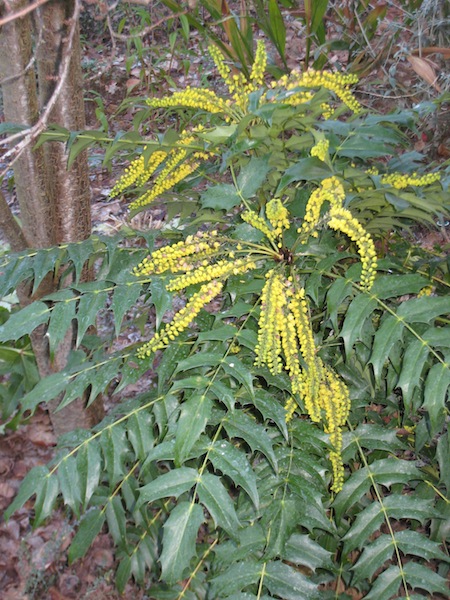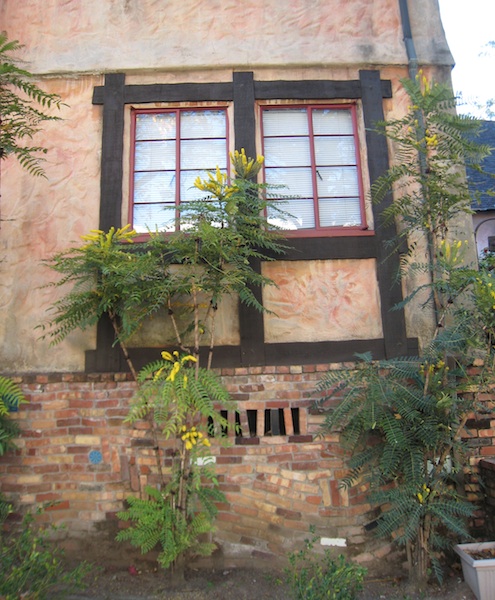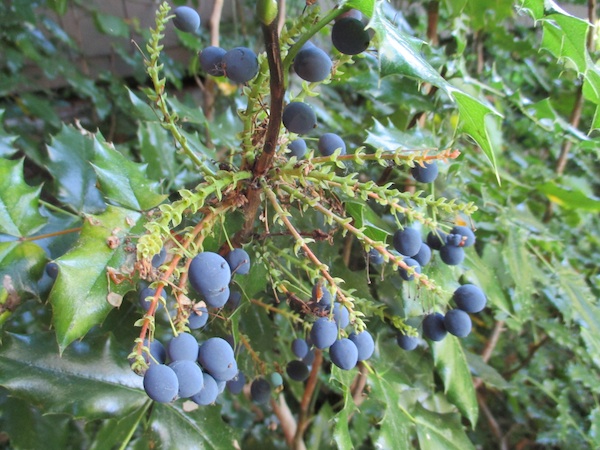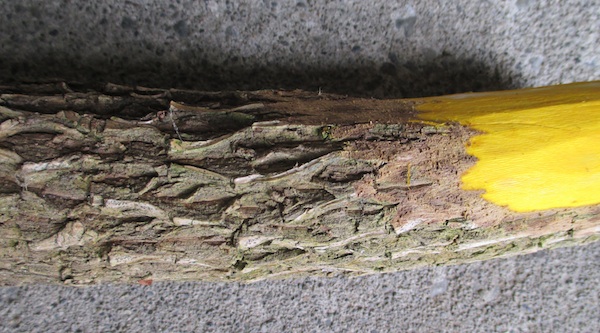| Depending on perspective, genus Mahonia shrubs are either related closely to genus Berberis --or are a mere well-defined subgenus of Berberis. |
| Because I am studying and writing about edible houseplants, and three Mahonia species have been mentioned as suitable for indoor cultivation under the right circumstances, while no Berberis have been so cited, this month I write of Mahonia only. |
| There are dozens of Mahonia species, found either in east Asia or west America. China alone has at least 27 species, but according to the Flora of China, most Chinese wild Mahonia populations are extirpated, likely due to over-collecting for medicinal use. |
| Compared to Berberis, Mahonia stems are never regularly dimorphic; stems are spineless; leaves are evergreen, and pinnately compound; flower clusters are dense and elongated, 25 - 70 flowered; the shrubs are never susceptible to Puccinia (a rust disease). |
| The inner bark of the species is bright yellow with the alkaloid berberine, that is much used in medicine and as a dye. |
| Gardeners prize the bold foliage, cheerful bright flowers in winter or spring, and the fruit displays. Usually the flowers are yellow, tiny, in numerous slender upright clusters; sometimes they are aromatic. The spiny leaflets are the one major disadvantage. Due to those pain-inflicting leaves alone, some people avoid the plants. |
| Certain Mahonia grow in sun and resent summer irrigation; others grow in shade and require summer moisture to be at their best. The several species suggested as being suitable indoors, are of the latter. |
| Many species of Berberis and Mahonia have been reported as edible. Usually, it is the berries; rarely, the flowers or tender young leaves. They are almost always intensely sour. |
Below are those species of Mahonia that either have been reported as houseplants (3), or I have found edible (16) by experience or as reported in writing by others. Certainly other species, and especially hybrids, are also edible. But due to various alkaloids and bitterness in the plants, the safest course is to eat only fully ripe berries.
|
| Mahonia Aquifolium (Pursh) Nutt. |
| = Berberis Aquifolium Pursh |
| = Berberis pinnata Banks ex DC. 1821, non Lag. 1816, Roxb. 1832 |
| (Tall Oregon-Grape) |
| W North America. To 15 feet tall; leaflets thin, 5 - 13. |
Flowers, young tender leaves, and berries.
|
| Mahonia Bealei (Fortune) Pynaert |
| = M. japonica (Th. ex Murr.) DC. var. Bealei (Fortune) Fedde |
| = Berberis Bealei Fortune |
| (Leatherleaf Mahonia) |
| China. To 26 feet tall; leaflets 9 - 21. |
| Floridata.com: can be used as a large houseplant. |
Berries.
|
| Mahonia borealis Takeda |
| Himalayas. To 13 feet tall; leaflets 11 - 19. |
Berries.
|
| Mahonia Duclouxiana Gagnep. |
| = M. siamensis Takeda |
| China, India, Burma, Thailand. To 13 feet tall; leaflets 9 - 19. |
Berries.
|
| Mahonia Fortunei (Lindl.) Fedde |
| (Chinese Mahonia) |
| China. To 13 feet tall; leaflets 5 - 11. |
Floridata.com: can be grown as a containerized houseplant. Lacks the stiff and sharp leaf spines of other species.
|
| Mahonia Fremontii (Torr.) Fedde |
| = Berberis Fremontii Torr. |
| (Fremont Barberry. Desert Mahonia) |
| SW North America. To 14 feet tall; leaflets 5 - 11. |
Berries.
|
| Mahonia hæmatocarpa (Wooton) Fedde |
| = Berberis hæmatocarpa Wooton |
| (Mexican or Red Barberry) |
| N Mexico. To 13 feet tall; leaflets 3 - 9. |
Berries.
|
| Mahonia Harrisoniana (Kearney & Peebles) H.L. Li |
| = Berberis Harrisoniana Kearney & Peebles |
| (Kofa Mountain Barberry) |
| SW Arizona. To 5 feet tall; leaflets 3. |
Berries.
|
| Mahonia napaulensis DC. |
| = M. sikkimensis Takeda |
| = M. acanthifolia Wall. ex G. Don |
| = M. Leschenaultii (Wall. ex Wight & Arn.) Takeda ex Dunn |
| = Berberis nepalensis Spreng. |
| = Berberis Leschenaultii Wall. ex Wight & Arn. |
| = Berberis napaulensis (DC.) Laferr. var. L. (Wall. ex Wight & Arn.) Hook. f. & Thomson |
| Several species lumped above as per Flora of China, and European Garden Flora, --not the Plant List. |
| (Nepal Mahonia, Indian Barberry) |
| Bhutan, N India, Burma, Nepal, China. To 23 feet tall; leaflets 11 - 25. |
Berries.
|
| Mahonia nervosa (Pursh) Nutt. |
| = Berberis nervosa Pursh |
| (Low Oregon-Grape) |
| NW North America. To 4 feet tall; leaflets 11 - 23. |
Tender young leaves, and berries.
|
| Mahonia Nevinii (A. Gray) Fedde |
| = Berberis Nevinii A. Gray ex A. Gray & S. Watson |
| (Nevin's Barberry) |
| S California. To 13 feet tall; leaflets 3 - 7. |
Berries.
|
| Mahonia oiwakensis Hayata ssp. lomariifolia (Takeda) J.M.H. Shaw 2011 |
| = M. lomariifolia Takeda |
| (Chinese Holly-Grape) |
| W China. To 23 feet tall; leaflets 25 - 31. |
| Suggested as a houseplant. |
Berries.
|
| Mahonia pinnata Kunth 1823 |
| = Berberis pinnata Lag. 1816, non Banks ex DC. 1821, Roxb. 1832 |
| = Berberis moranensis Hebenstr. & Ludw. ex Schult. & Schult. f. |
| (California Barberry. Cluster Holly-Grape) |
| S Oregon, California, N Mexico. To 23 feet tall; leaflets 3 - 13. |
Berries.
|
| Mahonia pumila (Greene) Fedde |
| = Berberis pumila Greene |
| (Dwarf Oregon-Grape) |
| Oregon, California. To 1.5 feet tall; leaflets 3 - 9. |
Berries.
|
| Mahonia repens (Lindl.) G. Don |
| = Berberis repens Lindl. |
| (Creeping Oregon-Grape or Mahonia) |
| Western N America. To 2 feet tall; leaflets 3 - 7. |
Berries.
|
| Mahonia Swaseyi (Buckley ex M.J. Young) Fedde |
| = Berberis Swaseyi Buckley ex M.J. Young |
| (Texas Mahonia or Barberry. Chaparral Berry) |
| Texas. To 5.5 feet tall; leaflets 5 - 9. |
Berries.
|
| Mahonia trifoliolata (Moric.) Fedde |
| = Berberis trifoliolata Moric. |
| NOT = Berberis trifolia Schltdl. & Cham. |
| (Mexican Barberry. Texas Currant. Agarita / Agarito) |
| Arizona, New Mexico, Texas; N Mexico. To 11.5 feet tall; leaflets 3. |
Berries.
|
Be cautious if you experiment.
Back |

Mahonia hybrid 'Charity'; photo by ALJ
|

Mahonia lomariifolia; photo by ALJ
|

Mahonia Aquifolium showing a ripe fruit; photo by ALJ
|

Mahonia bark showing yellow inside; photo by ALJ
|

